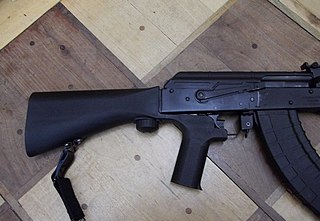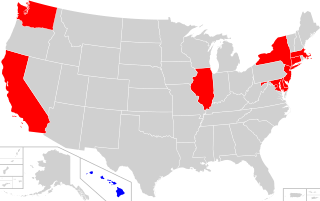Related Research Articles

A firearm is any type of gun that uses an explosive charge and is designed to be readily carried and operated by an individual. The term is legally defined further in different countries.

A machine gun (MG) is a fully automatic and rifled firearm designed for sustained direct fire with rifle cartridges. Other automatic firearms such as automatic shotguns and automatic rifles are typically designed more for firing short bursts rather than continuous firepower and are not considered true machine guns. Submachine guns fire handgun cartridges rather than rifle cartridges, therefore they are not considered machine guns, while automatic firearms of 20 mm (0.79 in) caliber or more are classified as autocannons rather than machine guns.

The National Firearms Act (NFA), 73rd Congress, Sess. 2, ch. 757, 48 Stat. 1236 was enacted on June 26, 1934, and currently codified and amended as I.R.C. ch. 53. The law is an Act of Congress in the United States that, in general, imposes an excise tax on the manufacture and transfer of certain firearms and mandates the registration of those firearms. The NFA is also referred to as Title II of the federal firearms laws, with the Gun Control Act of 1968 ("GCA") as Title I.

In firearms terminology and at law, the firearm frame or receiver is the part of a firearm which integrates other components by providing housing for internal action components such as the hammer, bolt or breechblock, firing pin and extractor, and has threaded interfaces for externally attaching ("receiving") components such as the barrel, stock, trigger mechanism and iron/optical sights. Various firearm receivers often come with 1 or 2 sections, the upper receiver which houses the barrel/trunnion, bolt components etc and the lower receiver that holds the fire control group, pistol grip, selector, stock etc.

A gunsmith is a person who repairs, modifies, designs, or builds guns. The occupation differs from an armorer, who usually replaces only worn parts in standard firearms. Gunsmiths do modifications and changes to a firearm that may require a very high level of craftsmanship, requiring the skills of a top-level machinist, a very skilled woodworker, and even an engineer. Gunsmiths perform factory-level repairs and renovations to restore well-used or deteriorated firearms to new condition. They may make alterations to adapt sporting guns to better fit the individual shooter that may require extensive modifications to the firearm's stocks and metal parts. Repairs and redesigns may require fabrication and fitting of unavailable parts and assemblies constructed by smiths themselves. Gunsmiths may also renew metal finishes or apply decorative carvings or engravings to guns. Many gun shops offer gunsmithing service on the premises.

An automatic firearm or fully automatic firearm is a self-loading firearm that continuously chambers and fires rounds when the trigger mechanism is actuated. The action of an automatic firearm is capable of harvesting the excess energy released from a previous discharge to feed a new ammunition round into the chamber, and then igniting the propellant and discharging the projectile by delivering a hammer or striker impact on the primer.
A hell-fire trigger is a device that allows a semi-automatic firearm to fire at an increased rate. The hell-fire clamps to the trigger guard behind the trigger and presses a "finger" against the back of the trigger to increase the force that returns the trigger to its forward position, effectively decreasing the time required for the trigger to reset, allowing for a faster follow up shot.

A firearm is said to fire from an open bolt or open breech if, when ready to fire, the bolt and working parts are held to the rear of the receiver, with no round in the chamber. When the trigger is actuated, the bolt travels forward, feeds a cartridge from the magazine or belt into the chamber, and fires that cartridge in the same movement. Like any other self-loading design, the action is cycled by the energy released from the propellant, which sends the bolt back to the rear, compressing the mainspring in readiness for firing the next round. In an open-bolt gun firing semi-automatically, the bolt is caught and held at this point by the sear after each shot; and in automatic open-bolt fire, it's caught and held in this manner whenever the trigger is released. In contrast to this, in closed-bolt guns, the trigger and sear do not affect the movement of the bolt directly.
A gunstock or often simply stock, the back portion of which is also known as a shoulder stock, a buttstock, or simply a butt, is a part of a long gun that provides structural support, to which the barrel, action, and firing mechanism are attached. The stock also provides a means for the shooter to firmly brace the gun and easily aim with stability by being held against the user's shoulder when shooting the gun, and helps to counter muzzle rise by transmitting recoil straight into the shooter's body.
The Armsel Striker, also known as the Sentinel Arms Co Striker-12, Protecta, Protecta Bulldog and SWD Street Sweeper is a 12-gauge shotgun with a revolving cylinder that was designed for riot control and combat.

Bump stocks or bump fire stocks are gun stocks that can be used to assist in bump firing, the act of using the recoil of a semi-automatic firearm to fire cartridges in rapid succession.

Short-barreled rifle broadly refers to any rifle with an unusually short barrel. The term carbine describes a production rifle with a reduced barrel length for easier handling in confined spaces. Concern about concealment for illegal purposes has encouraged regulations specifying minimum barrel lengths and overall lengths.
The following are terms related to firearms and ammunition topics.

Title II weapons, or NFA firearms, are designations of certain weapons under the United States National Firearms Act (NFA).

Assault weapons legislation in the United States refers to bills and laws that define and restrict or make illegal the manufacture, transfer, and possession of assault weapons. How these firearms are defined and regulated varies from jurisdiction to jurisdiction; generally, this constitutes a list of specific firearms and combinations of features on semiautomatic firearms.
The SIG MPX is a gas-operated submachine gun designed and manufactured by SIG Sauer, and is primarily chambered in 9×19mm Parabellum. It is a gas-operated firearm featuring a closed, rotating bolt. These design features, rare in submachine guns, were chosen to enhance the safety of the user and to have a more reliable firearm. It was designed in 2013 and was released to the general public in 2015. It features the SIG Sauer short stroke push-rod gas system to reduce the recoil and improve the reliability of the weapon.

A Glock switch is a small device that can be attached to the rear of the slide of a Glock handgun, converting the semi-automatic pistol into a selective fire machine pistol capable of fully automatic fire. As a type of auto sear, it functions by applying force to the trigger bar to prevent it from limiting fire to one round of ammunition per trigger pull. This device by itself, regardless if it is installed on a slide or not, is considered by the Bureau of Alcohol, Tobacco, Firearms and Explosives (ATF) to be a machine gun, making possession of the device illegal in the United States under most circumstances.
Garland v. Cargill, 602 U.S. 406 (2024), was a United States Supreme Court case regarding the classification of bump stocks as "machine guns" under the National Firearms Act of 1934 (NFA) by the United States Bureau of Alcohol, Tobacco, Firearms and Explosives (ATF) in 2018. In a 6-3 decision, the Supreme Court ruled that bump stocks are not machine guns for purposes of the NFA, vacating the ATF rule and finding that the ATF exceeded its statutory authority.
A binary trigger is a type of device that allows a semi-automatic firearm to fire at an increased rate. A binary trigger works by firing one shot upon pulling the trigger and then firing a subsequent shot upon release of the trigger.

A forced reset trigger is a device that allows a person to fire a semi-automatic firearm at an increased rate. The forced reset trigger works by mechanically resetting the trigger's position after a shot is fired. This allows for an increased rate of fire. However, the shooter must still manually pull the trigger each time it resets for any subsequent shot to be fired.
References
- ↑ "Rev. Ruling 1955–528 – Classification of crank-operated gear-driven Gatling guns". ATF . Internal Revenue Service. Archived from the original on May 31, 2023. Retrieved May 31, 2023.
- ↑ Bartlett, Curtis (January 2, 2001). "ATF Gatling Crank Approval Letter". 1919A4.com. ATF. Archived from the original on May 31, 2023. Retrieved May 31, 2023.
- ↑ Owen, Edward (January 5, 1997). "ATF Gatling Gun Letter". National Firearms Act Trade & Collectors Association. ATF. Archived from the original on May 31, 2023. Retrieved May 31, 2023.
- ↑ "ATF Ruling 2004–5 – Minigun Ruling". ATF. August 18, 2004. Archived from the original on May 31, 2023. Retrieved May 31, 2023.
- ↑ Smith, Aaron (April 1, 2021). "Biden's Gun Control Doesn't Target Gat Cranks Mimicking Machine Guns". Forbes. Retrieved May 31, 2023.
- ↑ Chipman, David; Nichols, Lindsay (November 15, 2017). "Legal and Lethal: 9 Products That Could Be The Next Bump Stock" (PDF). Brady Campaign . Brady Campaign. Archived from the original (PDF) on May 31, 2023. Retrieved May 31, 2023.